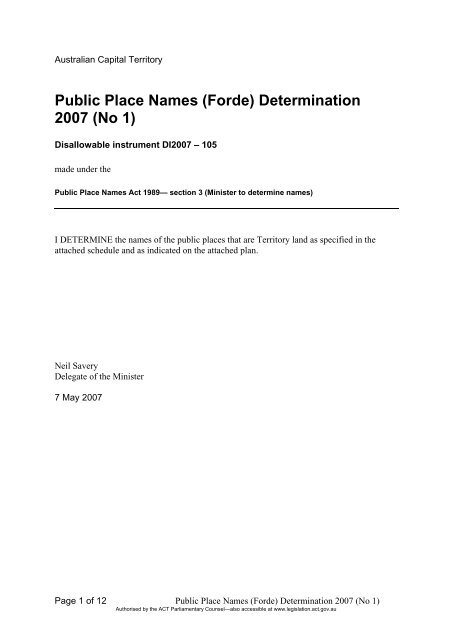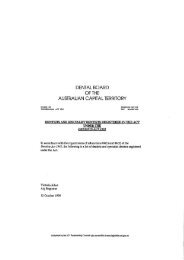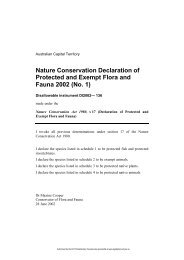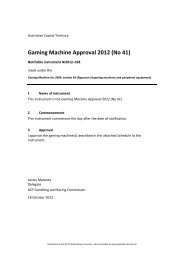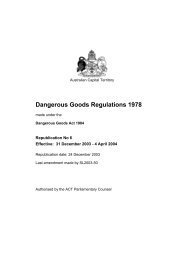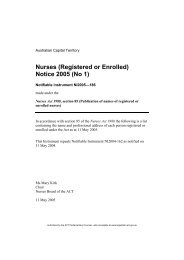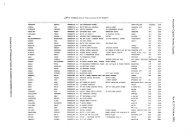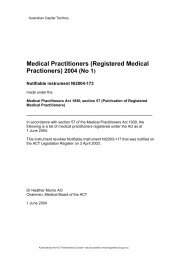Public Place Names (Forde) Determination 2007 (No 1)
Public Place Names (Forde) Determination 2007 (No 1)
Public Place Names (Forde) Determination 2007 (No 1)
Create successful ePaper yourself
Turn your PDF publications into a flip-book with our unique Google optimized e-Paper software.
Australian Capital Territory<br />
<strong>Public</strong> <strong>Place</strong> <strong>Names</strong> (<strong>Forde</strong>) <strong>Determination</strong><br />
<strong>2007</strong> (<strong>No</strong> 1)<br />
Disallowable instrument DI<strong>2007</strong> – 105<br />
made under the<br />
<strong>Public</strong> <strong>Place</strong> <strong>Names</strong> Act 1989— section 3 (Minister to determine names)<br />
I DETERMINE the names of the public places that are Territory land as specified in the<br />
attached schedule and as indicated on the attached plan.<br />
Neil Savery<br />
Delegate of the Minister<br />
7 May <strong>2007</strong><br />
Page 1 of 12 <strong>Public</strong> <strong>Place</strong> <strong>Names</strong> (<strong>Forde</strong>) <strong>Determination</strong> <strong>2007</strong> (<strong>No</strong> 1)<br />
Authorised by the ACT Parliamentary Counsel—also accessible at www.legislation.act.gov.au
SCHEDULE<br />
<strong>Public</strong> <strong>Place</strong> <strong>Names</strong> (<strong>Forde</strong>) <strong>Determination</strong> <strong>2007</strong> (<strong>No</strong> 1)<br />
Division of <strong>Forde</strong>: Community Service<br />
NAME ORIGIN SIGNIFICANCE<br />
Allnutt<br />
Crescent<br />
Marion Ellen<br />
Lea Allnutt<br />
(1896-1980)<br />
Welfare worker<br />
Marion Allnutt was born at Woodville Park, Adelaide. She<br />
studied piano at the Elder Conservatorium of Music.<br />
Marion served various committees for the benefit of children<br />
between 1927 to 1952 and acted as a transport officer in 1939-<br />
41 for the South Australian division of the Australian Red<br />
Cross Society. In 1949 she became a charter member of the<br />
Soroptimist Club of Adelaide (president 1951-53).<br />
In 1941 Marion was a founder of the South Australian unit of<br />
the Women's Australian National Services. During World<br />
War II she directed women in pre-enlistment training for the<br />
armed services and instructed members in air-raid precautions<br />
work and fire-fighting; she also supported the dispatch of food<br />
parcels to victims of the Blitz in Britain. In July 1944<br />
Commander Allnutt answered the Royal Adelaide Hospital's<br />
call for the W.A.N.S. to replace striking domestic workers. At<br />
a few hours notice, she arranged a complete service for nine<br />
days, despite accusations of 'scab' labour.<br />
In August 1944 she proposed that the W.A.N.S. should<br />
establish Wanslea, an emergency home for children. Fundraising<br />
began and Wanslea opened at Payneham in March<br />
1947; the home was later moved to Kingswood. The matron<br />
and staff cared for about thirty children in times of family<br />
crises; girls were trained as 'Wanslea aids' to take over the<br />
mothers' home duties when necessary.<br />
Miss Allnutt continued her work on Wanslea's council<br />
(1947-69 and 1975-80), on management and training<br />
committees, and in fundraising. In 1951 she was appointed<br />
M.B.E.<br />
Page 2 of 12 <strong>Public</strong> <strong>Place</strong> <strong>Names</strong> (<strong>Forde</strong>) <strong>Determination</strong> <strong>2007</strong> (<strong>No</strong> 1)<br />
Authorised by the ACT Parliamentary Counsel—also accessible at www.legislation.act.gov.au
NAME ORIGIN SIGNIFICANCE<br />
Cleggett Street Ella Cleggett<br />
(1884-1960)<br />
School teacher and welfare worker<br />
Ella Cleggett was born at Mount Barker, South Australia.<br />
Ella attended the local public school and was trained as a<br />
teacher. From 1906 she spent nineteen years with the South<br />
Australian Education Department. She taught at Flinders<br />
Street Model School, Adelaide, at Moonta, at Burra and at<br />
Mount Barker. There she contracted scarlet fever which left<br />
her with a permanent loss of hearing that eventually made her<br />
abandon classroom work.<br />
During World War I Ella was active in the Schools' Patriotic<br />
Fund. Her visits to Bedford Park Sanatorium provided<br />
opportunities to meet returned servicemen suffering from<br />
tuberculosis. In 1921 the Tubercular Sailors', Soldiers' and<br />
Airmen's Association formed the Tubercular Soldiers' Aid<br />
Society of South Australia, a fund-raising and welfare<br />
organization, of which Ella became honorary secretary. In<br />
1924 Cleggett took leave from the Education Department to<br />
raise money for the T.B.S.A.S. and the next year became the<br />
society's full-time, paid secretary.<br />
Her joking, almost frivolous, manner gave former diggers the<br />
impression that she was 'just a girl', but she was a woman of<br />
energy and determination who was devoted to her cause. Ella<br />
often sat up each night for weeks, reading by candlelight to a<br />
dying man; she looked after orphans; she tramped the city<br />
seeking light work for the afflicted. She treated tubercular<br />
soldiers as if they were her brothers, offering hope and<br />
reassurance to her charges and their families who called her<br />
'Auntie Cleggett'. Intent on counteracting the stigma attached<br />
to 'the shadow of T.B.', she named the society's newsletter the<br />
Optimist.<br />
Ella established Angorichina Hostel in the warm, dry<br />
Flinders Ranges where patients learned to craft fine furniture<br />
from the offcuts of red-gum railway sleepers. The workshop<br />
was transferred to Adelaide in the 1930s, but the hostel was<br />
retained (until 1973) and remained her main concern.<br />
In 1951 Miss Cleggett was granted honorary life membership<br />
of the Returned Sailors', Soldiers' and Airmen's Imperial<br />
League of Australia and was appointed M.B.E.<br />
Page 3 of 12 <strong>Public</strong> <strong>Place</strong> <strong>Names</strong> (<strong>Forde</strong>) <strong>Determination</strong> <strong>2007</strong> (<strong>No</strong> 1)<br />
Authorised by the ACT Parliamentary Counsel—also accessible at www.legislation.act.gov.au
NAME ORIGIN SIGNIFICANCE<br />
Denoon Street<br />
Pamela Denoon<br />
(1942-1988)<br />
Feminist & Canberra resident<br />
Pamela Denoon, nee Todd, was born in Toowoomba, Qld and<br />
graduated with a Bachelor of Science from Queensland<br />
University. She worked as a biochemist in Cambridge, UK,<br />
where she met her husband Donald Denoon. From 1966 until<br />
1972 she lived in Uganda, where she worked at Makerere<br />
University and where her three children were born.<br />
In 1972 the Denoons moved to Port Moresby, where Pamela<br />
studied politics and sociology at the University of Papua New<br />
Guinea. Her experiences of racism in Makerere and Port<br />
Moresby fuelled her interest in these subjects. She graduated<br />
in 1977 with a BA Hons and worked in the Papua New<br />
Guinea Planning Office. She later took out an MA in<br />
Sociology from the London School of Economics, becoming<br />
well-read in feminist theory, in addition to her strong personal<br />
commitment to issues of social justice.<br />
In 1981 the Denoons came to Canberra, where Pamela worked<br />
for the Abortion Counselling service. In 1982 Pamela was<br />
appointed National Co-ordinator of the Women's Electoral<br />
Lobby, a position she held until 1984. She played a major role<br />
in co-ordinating the campaigns for the ratification of the UN<br />
Women's Convention (CEDAW) and for the passage of the<br />
Commonwealth Sex Discrimination Act. She built up the<br />
WEL National Office.<br />
She worked hard for the WEL team at the Economic Summit<br />
in 1983, and in putting together the coalition supporting the<br />
Sex Discrimination Act. After she left WEL she worked<br />
briefly for the Urban Research Unit at the ANU and then in<br />
the Office of Local Government. She continued to shoulder<br />
considerable responsibility for WEL, including lobbying for<br />
the Affirmative Action Act, helping prepare the National<br />
Women's Tax Summit in 1985 and the National Agenda for<br />
Women Conference in 1986. Her work in the public service<br />
enabled her to promote equal opportunity in local<br />
government.<br />
Pamela’s health forced her to retire from the public service<br />
but her commitment to the women's movement was<br />
undiminished. Pamela planned and provided the funding to<br />
establish the National Foundation for Australian Women &<br />
the Pamela Denoon Trust.<br />
Page 4 of 12 <strong>Public</strong> <strong>Place</strong> <strong>Names</strong> (<strong>Forde</strong>) <strong>Determination</strong> <strong>2007</strong> (<strong>No</strong> 1)<br />
Authorised by the ACT Parliamentary Counsel—also accessible at www.legislation.act.gov.au
NAME ORIGIN SIGNIFICANCE<br />
Helen Leonard<br />
Crescent<br />
Helen Leonard<br />
(1945-2001)<br />
Feminist, activist, community educator, Canberra resident<br />
tivist, cmmunity educator<br />
Helen Leonard was born in Sydney, NSW. She attended<br />
Hornsby Girls High School, and then moved on to Sydney's<br />
Royal <strong>No</strong>rth Shore Hospital as a student nurse.<br />
In 1973, she became an active member of Nursing Mothers<br />
Association of Australia through localised group leadership<br />
and counselling. In 1988, she was appointed to the National<br />
Women's Consultative Council as the representative of the<br />
Nursing Mothers Association (now the Australian<br />
Breastfeeding Association).<br />
At the same time as her appointment to the National Women's<br />
Consultative Council, she was a co-director of Distaff<br />
Associates, a co-convenor of WRITES, the umbrella<br />
organisation for the Women's Economic Think Tank, and was<br />
also involved with Refractory Girl, the Women's Radio<br />
Network and other groups. Helen made a number of other<br />
notable contributions during her time with the National<br />
Women's Consultative Council, including the organisation of<br />
the Women's Tax Convention in Canberra.<br />
Helen founded the National Women's Media Centre, after<br />
identifying the fact that only 20 per cent of interviewees in the<br />
media were women. She led the project that produced the<br />
1998 national women's media directory.<br />
Helen moved to Canberra in 1998, to become national<br />
executive officer for the Women's Electoral Lobby. She then<br />
moved on to the position of executive officer of the Women's<br />
Services Network. She remained in this role until the time of<br />
her death, while also being involved with the National Breast<br />
Cancer Foundation, the National Women's Media Centre and,<br />
through the women's history month, the Coalition of<br />
Australian Participating Organisations of Women, or<br />
CAPOW. As a consultant, she was involved with a range of<br />
other groups.<br />
Page 5 of 12 <strong>Public</strong> <strong>Place</strong> <strong>Names</strong> (<strong>Forde</strong>) <strong>Determination</strong> <strong>2007</strong> (<strong>No</strong> 1)<br />
Authorised by the ACT Parliamentary Counsel—also accessible at www.legislation.act.gov.au
NAME ORIGIN SIGNIFICANCE<br />
Jessie Street<br />
Jessie Mary<br />
Grey Street<br />
(1889-1970)<br />
Feminist and community worker<br />
Jessie Street was born in India and grew up on her<br />
grandfather’s property Yulgilbar in northern NSW. She was<br />
schooled in England at Wycombe Abbey School,<br />
Buckinghamshire, from 1903, returning to Australia in 1906.<br />
She graduated in 1911 with a Bachelor of Arts from the<br />
University of Sydney, having founded the Sydney University<br />
Women's Sports Association the previous year.<br />
Jessie Street was recognised nationally and internationally for<br />
her activism in women's rights, social justice and peace. Jessie<br />
campaigned for equality of status for women, equal pay, the<br />
appointment of women to public office and the election of<br />
women to parliament. Co-founder of the NSW Social Hygiene<br />
Association (1916) and co-founder (1929) and President of<br />
the United Associations of Women, in 1945 she was the only<br />
woman on the Australian delegation to the founding<br />
conference of the United Nations, campaigning with women<br />
delegates from South America and Scandinavia for the<br />
establishment of the UN Commission on the Status of Women<br />
and the Charter of Women's Rights. In the postwar years she<br />
campaigned internationally for peace and for the status of<br />
women. In 1957 she initiated the campaign to remove clauses<br />
discriminating against Aboriginal people from the Australian<br />
Constitution that resulted in the successful Referendum in<br />
1967.<br />
Page 6 of 12 <strong>Public</strong> <strong>Place</strong> <strong>Names</strong> (<strong>Forde</strong>) <strong>Determination</strong> <strong>2007</strong> (<strong>No</strong> 1)<br />
Authorised by the ACT Parliamentary Counsel—also accessible at www.legislation.act.gov.au
NAME ORIGIN SIGNIFICANCE<br />
Miljanovic<br />
Street<br />
Dragan<br />
Miljanovic<br />
(1922-1974)<br />
Charity worker<br />
Dragan Miljanovic was born on 3 September 1922 at Bunic,<br />
Lica, Yugoslavia. Educated locally, Dragan was raised by his<br />
grandmother after his parents moved to France to seek<br />
employment during the Depression. He worked as a shepherd<br />
until 1937 when he joined his parents and became a labourer<br />
in the north of France. Following the outbreak of World War<br />
II he served in the resistance movement, but in 1940 was<br />
conscripted into a Nazi labour camp in the Ruhr valley,<br />
Germany. He escaped and made his way to Munich. When<br />
the war ended he spent two years in Germany in a displacedpersons'<br />
camp, run by the United Nations Educational,<br />
Scientific and Cultural Organization. His care of the sick and<br />
hungry was widely appreciated: known as 'Francuz' ('the<br />
Frenchie'), he was able, against all odds, to find food from a<br />
range of sources.<br />
In 1948 he emigrated to Sydney. After a term in the<br />
immigration centre at Bathurst, he spent four years in a<br />
similar camp at Woodside, South Australia. He drove for the<br />
Department of Supply before being naturalized on 25 August<br />
1953. In 1954 he married Tamara Kutschuk. They lived at<br />
Stirling in the Adelaide Hills where Miljanovic found a job as<br />
a gardener. He began twenty years of unselfish service to<br />
others, initially through the Good Neighbour Council of South<br />
Australia which helped immigrants to assimilate. With his<br />
donkey, Don Pedro, he patrolled Adelaide beaches in 1961-<br />
62, collecting money for the surf life-saving movement; he<br />
also gave children rides on Don Pedro at charitable functions.<br />
He often dressed in a tasselled pillbox hat, red scarf, white<br />
shirt and riding-breeches, and sang folk-songs while<br />
accompanying himself on a shepherd's lute, a tamboritza or a<br />
gusla.<br />
By 1963 Miljanovic was employed as a monotype-operator in<br />
Adelaide. That year he won the Gertrude Kumm award for<br />
citizenship, presented annually to an immigrant who had<br />
made an outstanding contribution to the community. In the<br />
same year, to assist young artists, he opened the Don Pedro<br />
Gallery in a nineteenth-century cottage which he had restored<br />
at Stirling. Miljanovic demonstrated his concern for the<br />
underdog by establishing the Independent Youth Club; his<br />
passionate interest in the conservation of the Adelaide Hills<br />
led him to found the Mount Lofty Ranges Association.<br />
Late in life Miljanovic worked as a surveyor's assistant. His<br />
formidable drive and eccentricity had made him a<br />
compassionate and colourful figure. In 1975 a plaque in his<br />
memory was unveiled at the Heart Centre, Adelaide.<br />
Page 7 of 12 <strong>Public</strong> <strong>Place</strong> <strong>Names</strong> (<strong>Forde</strong>) <strong>Determination</strong> <strong>2007</strong> (<strong>No</strong> 1)<br />
Authorised by the ACT Parliamentary Counsel—also accessible at www.legislation.act.gov.au
NAME ORIGIN SIGNIFICANCE<br />
Octoman<br />
Street<br />
Janetta Hannum<br />
Octoman<br />
(1879-1971)<br />
Community worker<br />
Janetta Octoman nee Provis was born at Port Lincoln, South<br />
Australia. She was educated by her grandfather Joseph<br />
Provis. In 1903 she married Charles Ochtomann (Octoman<br />
from 1919). Around 1920 the family moved to Marden,<br />
Adelaide.<br />
Early in 1927 the Octomans returned to the Eyre Peninsula.<br />
Mrs Octoman served as a justice of the peace. A member of a<br />
policy-forming committee of the Liberal Union of South<br />
Australia for the 1927 State elections, she was appointed to<br />
the State executive of the Liberal and Country League in<br />
1932. Five years later she unsuccessfully sought endorsement<br />
for the Legislative Assembly seat of Flinders. She was a<br />
founding member (1933) of the Tumby Bay branch of the<br />
South Australian Country Women's Association and president<br />
(1937-40, 1943-46) of the Eyre Peninsula division. In 1938<br />
she represented the S.A.C.W.A. on the executive-committee<br />
of the Associated Country Women of the World at its<br />
meetings in London, and at the Jubilee conference of the<br />
International Council of Women, held in Edinburgh.<br />
Concerned to ensure that women had a voice in parliament,<br />
Octoman came home and resumed her battle for party<br />
endorsement. As a member both of the C.W.A. and the<br />
National Council of Women of South Australia, she became<br />
known for her efforts to help women and children; and to<br />
improve education, transport and postal services on the Eyre<br />
Peninsula. During World War II she also threw her energies<br />
into the Australian Red Cross Society, the Fighting Forces<br />
Comforts Fund, the Wheatgrowers' Protection Association<br />
and the Mothers and Babies' Health Association. Despite her<br />
ability and perseverance, she never won pre-selection.<br />
After her husband died in 1949, Octoman served (1949-52,<br />
1955-56) as State president of the C.W.A. (honorary life<br />
member 1954). During her first term of office she visited all<br />
236 State branches, a formidable undertaking for a woman in<br />
her seventies. She helped to acquire land for holiday cottages<br />
at Port Lincoln and Tumby Bay, and initiated the<br />
establishment of homemakers' schools. In 1953 she was<br />
appointed M.B.E.<br />
A skilled needlewoman, and a keen gardener and cook,<br />
Octoman won prizes at the Adelaide Royal Show where she<br />
sometimes had as many as 150 entries. In 1970 the C.W.A.<br />
and the Tumby Bay District Council planted an avenue of<br />
native trees at Lipson in her honour.<br />
Page 8 of 12 <strong>Public</strong> <strong>Place</strong> <strong>Names</strong> (<strong>Forde</strong>) <strong>Determination</strong> <strong>2007</strong> (<strong>No</strong> 1)<br />
Authorised by the ACT Parliamentary Counsel—also accessible at www.legislation.act.gov.au
NAME ORIGIN SIGNIFICANCE<br />
Oke Street<br />
Marjorie<br />
Elizabeth Oke<br />
(1911-2003)<br />
Community worker<br />
Marjorie (Marj) Oke was born in Richmond, Victoria to a<br />
community activist mother and a trade unionist father.<br />
Marjorie left school in the Great Depression. Her first job<br />
was as a teacher in a one-room school. Upon her marriage in<br />
1942, as was the policy of the time, she was suspended from<br />
teaching.<br />
She got a job at the Australian Jam Company where she<br />
encountered very poor working conditions. This experience<br />
propelled her to join the Food Preservers’ Union and become<br />
active in the Australian Labor Party.<br />
In 1950, Marjorie became a founding and lifelong member of<br />
the Union of Australian Women. After returning to teaching<br />
in Moe, she campaigned for equal pay for women teachers,<br />
the abolition of the marriage bar and access to superannuation.<br />
Additionally, she formed a branch of the Aboriginal<br />
Advancement League and became, in 1992, a founding<br />
member of the Network for Older Women.<br />
On 10 June 1991 she was awarded an OAM (Medal of the<br />
Order of Australia) for service to aged people, particularly<br />
women.<br />
Marjorie was included in the Victorian Honour Roll of<br />
Women in March 2002.<br />
Page 9 of 12 <strong>Public</strong> <strong>Place</strong> <strong>Names</strong> (<strong>Forde</strong>) <strong>Determination</strong> <strong>2007</strong> (<strong>No</strong> 1)<br />
Authorised by the ACT Parliamentary Counsel—also accessible at www.legislation.act.gov.au
NAME ORIGIN SIGNIFICANCE<br />
Paquita Street<br />
Francisca<br />
Adriana<br />
(Paquita)<br />
Mawson<br />
(1891-1974)<br />
Community worker and writer<br />
Francisca Adriana (Paquita) Mawson nee Delprat was born at<br />
Acton, London. Paquita spent the first eight years of her life<br />
in Andalusia, Spain, where her father was working as a<br />
mining engineer. In 1898 Delprat moved to Broken Hill, New<br />
South Wales, where he had joined the Broken Hill Pty Co.<br />
Next year, his wife and five of their children arrived from<br />
Europe.<br />
Paquita attended the convent school at Broken Hill until, in<br />
1902, their father bought a house in <strong>No</strong>rth Adelaide. The<br />
Delprat girls were enrolled at Tormore House, a progressive<br />
private school in <strong>No</strong>rth Adelaide, where Paquita stayed until<br />
1908, after which she took piano and singing lessons at the<br />
Elder Conservatorium of Music.<br />
In 1914 Paquita married (Sir) Douglas Mawson, geologist and<br />
explorer. Their daughter Patricia was born in March 1915 in<br />
the Delprat family home in Melbourne. Paquita left the infant<br />
with Henrietta Delprat in 1916, while she journeyed through<br />
war-torn waters to join her husband at Liverpool, England,<br />
where he worked in the explosives section of the Ministry of<br />
Munitions. Lady Mawson made hospital dressings and<br />
worked as Sir Douglas's secretary in the afternoons. They<br />
moved to London in September 1917 and their second child<br />
Jessica was born there the following month. The Mawsons<br />
returned to Australia early in 1919 and built a house in the<br />
Adelaide seaside suburb of Brighton, where they spent the<br />
remainder of their married life.<br />
Lady Mawson took active roles in the University Wives', the<br />
Lyceum and the Queen Adelaide clubs. For thirty years she<br />
was involved with the Mothers' and Babies' Health<br />
Association, including nine years as president, and travelled<br />
by train to many country areas to spread the message of good<br />
infant care. He retired from the MBHA in June 1949. During<br />
World War II she also worked tirelessly as the convenor of<br />
the civilian relief department of the South Australian branch<br />
of the Australian Red Cross Society. She was appointed<br />
officer of the Order of Oranje-Nassau (1946), in recognition<br />
of the help she gave to Dutch refugees, and O.B.E. in 1951.<br />
Lady Mawson made her own contribution to Antarctic<br />
knowledge in writing Mawson of the Antarctic (London,<br />
1964). She also wrote A Vision of Steel, a biography of her<br />
father (Melbourne, 1958).<br />
Page 10 of 12 <strong>Public</strong> <strong>Place</strong> <strong>Names</strong> (<strong>Forde</strong>) <strong>Determination</strong> <strong>2007</strong> (<strong>No</strong> 1)<br />
Authorised by the ACT Parliamentary Counsel—also accessible at www.legislation.act.gov.au
NAME ORIGIN SIGNIFICANCE<br />
Rubeo Street<br />
Elena Domenica<br />
Luisa Rubeo<br />
(1896-1979)<br />
Community worker<br />
Elena Domenica Luisa Rubeo was born in Rome and arrived<br />
in Adelaide with her parents and brother aboard the Seydlitz in<br />
1908. She was educated at the Convent of Mercy school. In<br />
1912 the family moved to Ruthven Mansions, a luxury<br />
apartment building in Pulteney Street, where they opened an<br />
elegant restaurant, Café Rubeo, which offered authentic<br />
Roman cuisine and live music. After her brothers enlisted in<br />
the Australian Imperial Force in 1914, she helped to manage<br />
the restaurant and became active in the British (Australian)<br />
Red Cross Society. She later received a decoration from the<br />
Italian Red Cross. In 1920 her parents acquired a large house<br />
in Lefevre Terrace, <strong>No</strong>rth Adelaide; she was to live there for<br />
the rest of her life.<br />
Ella retained affection for Italy and frequently returned to<br />
Rome where she had many friends, including members of the<br />
Borghese family. Following one trip in 1927, she began to<br />
import fine goods, such as linen drapery and silk lingerie, to<br />
sell to her friends in Adelaide.<br />
Rubeo assisted newly arrived immigrants to cope with<br />
Australian laws and regulations, and was occasionally<br />
employed by Commonwealth departments as a translator. She<br />
taught Italian to Australians and (in 1934) to the children of<br />
Italian fishermen living at Glanville. She stopped teaching in<br />
1935 to care for her ailing parents.<br />
From 1945 Rubeo worked with renewed enthusiasm for the<br />
welfare of the Italian community. She sought work and<br />
housing for new arrivals, lent them money interest-free, acted<br />
as their confidante and interpreter, found them doctors and<br />
lawyers, and visited those who were confined in gaols,<br />
hospitals and asylums. Her voluntary work filled a need in a<br />
period of large-scale immigration when no appropriate<br />
government agency existed.<br />
Rubeo was registered as a business agent in March 1950. She<br />
aided Italians by translating documents, preparing wills and<br />
applications for repatriation, and arranging passages to and<br />
from Australia; for these services she charged a nominal fee.<br />
In 1952 she was appointed Italian consular-agent for South<br />
Australia (vice-consul from 1955), a position she held without<br />
remuneration until 1962. The consulate offices in Gilbert<br />
Terrace were transferred to her home so that she could be<br />
contacted by day and night. She also ran (from 1960) a travel<br />
agency, Arrow Travel Express, in the city.<br />
In 1977 she was awarded the O.A.M.<br />
Page 11 of 12 <strong>Public</strong> <strong>Place</strong> <strong>Names</strong> (<strong>Forde</strong>) <strong>Determination</strong> <strong>2007</strong> (<strong>No</strong> 1)<br />
Authorised by the ACT Parliamentary Counsel—also accessible at www.legislation.act.gov.au
Page 12 of 12 <strong>Public</strong> <strong>Place</strong> <strong>Names</strong> (<strong>Forde</strong>) <strong>Determination</strong> <strong>2007</strong> (<strong>No</strong> 1)<br />
Authorised by the ACT Parliamentary Counsel—also accessible at www.legislation.act.gov.au


